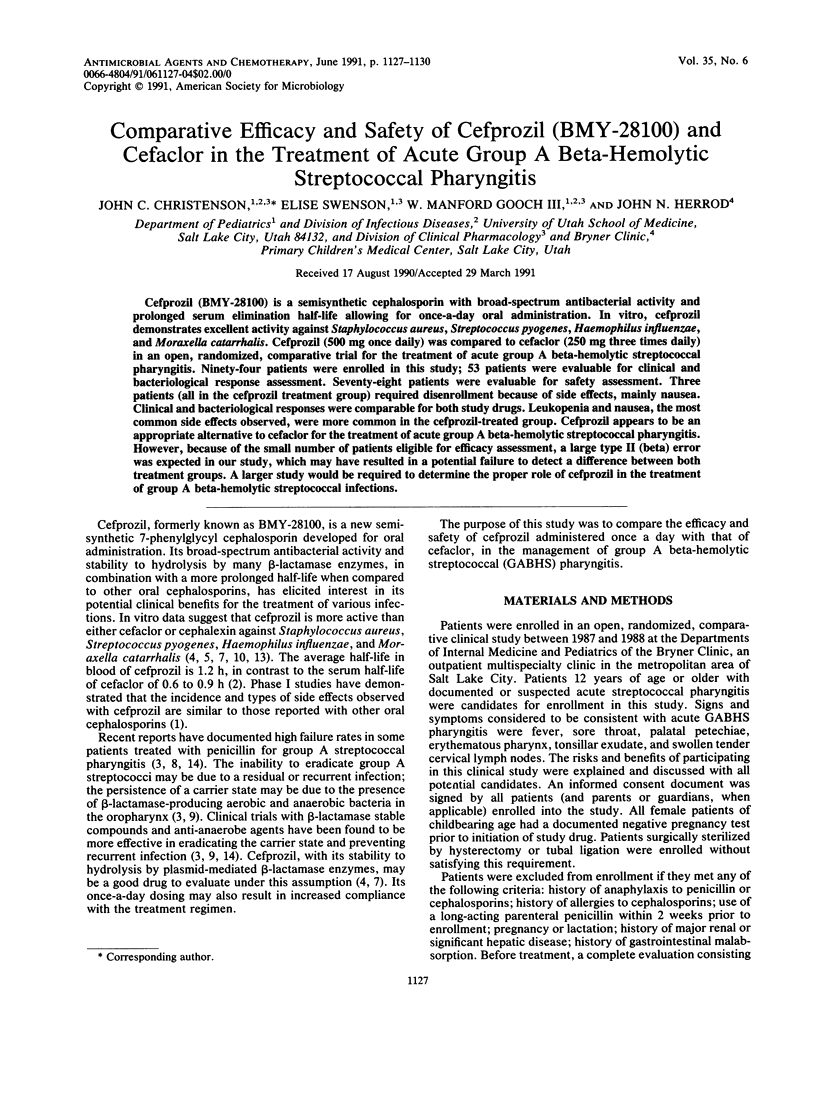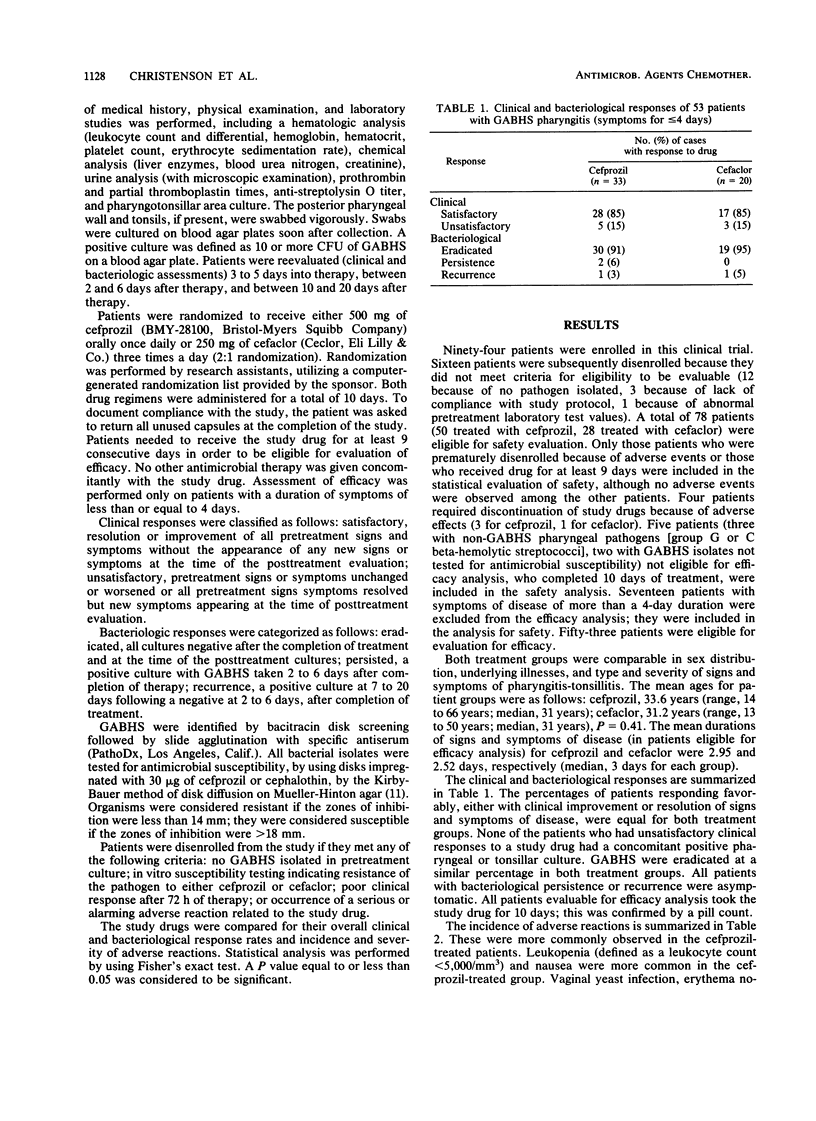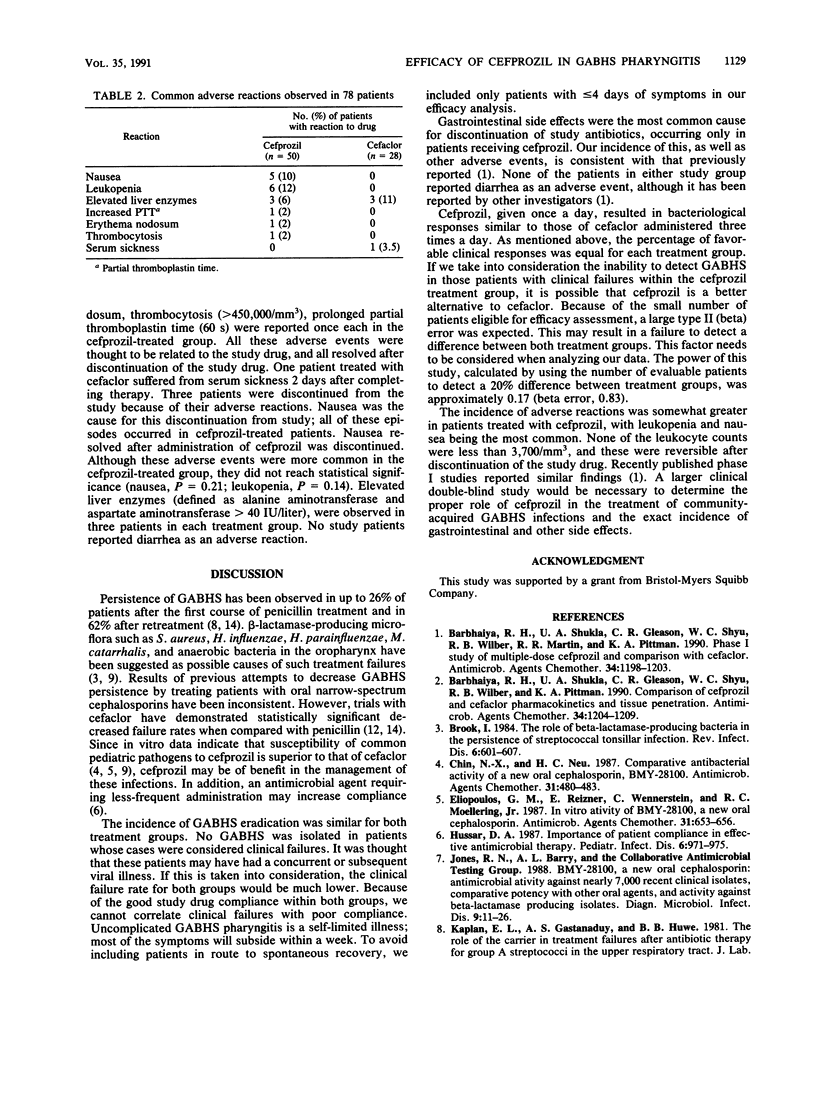Abstract
Cefprozil (BMY-28100) is a semisynthetic cephalosporin with broad-spectrum antibacterial activity and prolonged serum elimination half-life allowing for once-a-day oral administration. In vitro, cefprozil demonstrates excellent activity against Staphylococcus aureus, Streptococcus pyogenes, Haemophilus influenzae, and Moraxella catarrhalis. Cefprozil (500 mg once daily) was compared to cefaclor (250 mg three times daily) in an open, randomized, comparative trial for the treatment of acute group A beta-hemolytic streptococcal pharyngitis. Ninety-four patients were enrolled in this study; 53 patients were evaluable for clinical and bacteriological response assessment. Seventy-eight patients were evaluable for safety assessment. Three patients (all in the cefprozil treatment group) required disenrollment because of side effects, mainly nausea. Clinical and bacteriological responses were comparable for both study drugs. Leukopenia and nausea, the most common side effects observed, were more common in the cefprozil-treated group. Cefprozil appears to be an appropriate alternative to cefaclor for the treatment of acute group A beta-hemolytic streptococcal pharyngitis. However, because of the small number of patients eligible for efficacy assessment, a large type II (beta) error was expected in our study, which may have resulted in a potential failure to detect a difference between both treatment groups. A larger study would be required to determine the proper role of cefprozil in the treatment of group A beta-hemolytic streptococcal infections.
Full text
PDF



Selected References
These references are in PubMed. This may not be the complete list of references from this article.
- Barbhaiya R. H., Shukla U. A., Gleason C. R., Shyu W. C., Wilber R. B., Martin R. R., Pittman K. A. Phase I study of multiple-dose cefprozil and comparison with cefaclor. Antimicrob Agents Chemother. 1990 Jun;34(6):1198–1203. doi: 10.1128/aac.34.6.1198. [DOI] [PMC free article] [PubMed] [Google Scholar]
- Barbhaiya R. H., Shukla U. A., Gleason C. R., Shyu W. C., Wilber R. B., Pittman K. A. Comparison of cefprozil and cefaclor pharmacokinetics and tissue penetration. Antimicrob Agents Chemother. 1990 Jun;34(6):1204–1209. doi: 10.1128/aac.34.6.1204. [DOI] [PMC free article] [PubMed] [Google Scholar]
- Brook I. The role of beta-lactamase-producing bacteria in the persistence of streptococcal tonsillar infection. Rev Infect Dis. 1984 Sep-Oct;6(5):601–607. doi: 10.1093/clinids/6.5.601. [DOI] [PubMed] [Google Scholar]
- Chin N. X., Neu H. C. Comparative antibacterial activity of a new oral cephalosporin, BMY-28100. Antimicrob Agents Chemother. 1987 Mar;31(3):480–483. doi: 10.1128/aac.31.3.480. [DOI] [PMC free article] [PubMed] [Google Scholar]
- Eliopoulos G. M., Reiszner E., Wennersten C., Moellering R. C., Jr In vitro activity of BMY-28100, a new oral cephalosporin. Antimicrob Agents Chemother. 1987 Apr;31(4):653–656. doi: 10.1128/aac.31.4.653. [DOI] [PMC free article] [PubMed] [Google Scholar]
- Hussar D. A. Importance of patient compliance in effective antimicrobial therapy. Pediatr Infect Dis J. 1987 Oct;6(10):971–975. doi: 10.1097/00006454-198710000-00036. [DOI] [PubMed] [Google Scholar]
- Jones R. N., Barry A. L. BMY-28100, a new oral cephalosporin: antimicrobial activity against nearly 7,000 recent clinical isolates, comparative potency with other oral agents, and activity against beta-lactamase producing isolates. Diagn Microbiol Infect Dis. 1988 Jan;9(1):11–26. doi: 10.1016/0732-8893(88)90056-9. [DOI] [PubMed] [Google Scholar]
- KUNDSIN R. B., MILLER J. M. SIGNIFICANCE OF THE STAPHYLOCOCCUS AUREUS CARRIER STATE IN THE TREATMENT OF DISEASE DUE TO GROUP A STREPTOCOCCI. N Engl J Med. 1964 Dec 31;271:1395–1397. doi: 10.1056/NEJM196412312712705. [DOI] [PubMed] [Google Scholar]
- Leitner F., Pursiano T. A., Buck R. E., Tsai Y. H., Chisholm D. R., Misiek M., Desiderio J. V., Kessler R. E. BMY 28100, a new oral cephalosporin. Antimicrob Agents Chemother. 1987 Feb;31(2):238–243. doi: 10.1128/aac.31.2.238. [DOI] [PMC free article] [PubMed] [Google Scholar]
- Rodriguez W. J., Ross S., Schwartz R., Goldenberg R., Khan W. Cefaclor in the treatment of susceptible infections in infants and children. Postgrad Med J. 1979;55 (Suppl 4):35–38. [PubMed] [Google Scholar]
- Scribner R. K., Marks M. I., Finkhouse B. D. In vitro activity of BMY-28100 against common isolates from pediatric infections. Antimicrob Agents Chemother. 1987 Apr;31(4):630–631. doi: 10.1128/aac.31.4.630. [DOI] [PMC free article] [PubMed] [Google Scholar]
- Stillerman M. Comparison of oral cephalosporins with penicillin therapy for group A streptococcal pharyngitis. Pediatr Infect Dis. 1986 Nov-Dec;5(6):649–654. doi: 10.1097/00006454-198611000-00010. [DOI] [PubMed] [Google Scholar]


